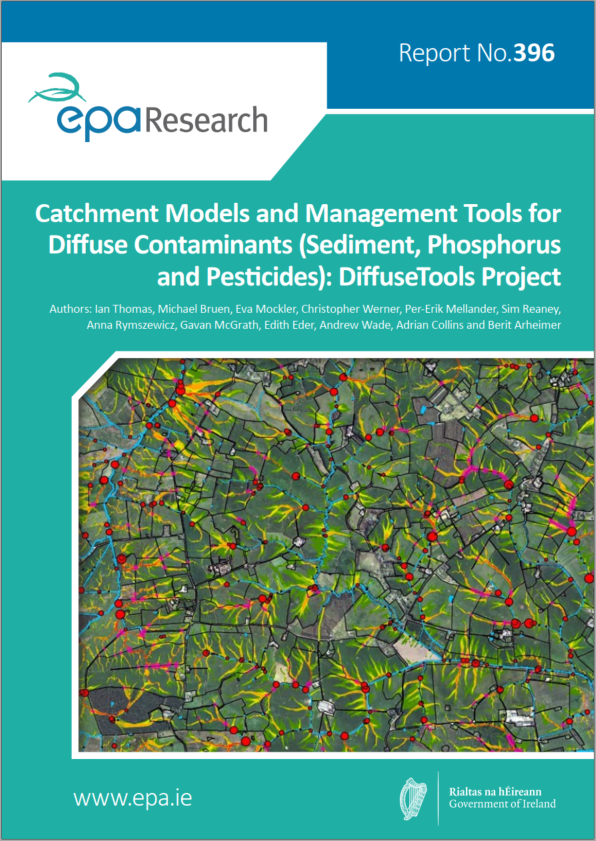Research 396: Catchment Models and Management Tools for Diffuse Contaminants (Sediment, Phosphorus and Pesticides): DiffuseTools Project
Authors: Ian Thomas, Michael Bruen, Eva Mockler, Christopher Werner, Per-Erik Mellander, Sim Reaney, Anna Rymszewicz, Gavan McGrath, Edith Eder, Andrew Wade, Adrian Collins and Berit Arheimer
Summary: Eutrophication, often driven by phosphorus, is the most significant issue for inland surface waters in Ireland. Half of Irish river water bodies still require improvements to bring them to good status, as required by the Water Framework Directive (WFD) (2000/60/EC). This research contributes to Ireland’s response to the third River Basin Management Plan of the WFD and to the development and implementation of more sustainable and cost-effective agricultural policies.

Project Highlights
Watch the project highlights video
Identifying Pressures
Eutrophication, often driven by phosphorus, is the most significant issue for inland surface waters in Ireland. Half of Irish river water bodies still require improvements to bring them to good status, as required by the Water Framework Directive (WFD) (2000/60/EC). The agricultural sector is a major source of phosphorus pollution in Irish rivers; however, because of its combined diffuse and point source characteristics, it is also often the most difficult source to quantify and manage. Furthermore, although some sediment is a natural component of healthy rivers, too much can also have an impact on their morphological and biological status. Pesticides are a vital part of agricultural systems, but they also pose a threat to both human and animal health, and to water quality. The DiffuseTools project has addressed the characterisation and modelling of all three of these major pressures (i.e. phosphorus, sediment and pesticides) on Irish rivers.
Informing Policy
This research contributes to Ireland’s response to the third River Basin Management Plan of the WFD and to the development and implementation of more sustainable and cost-effective agricultural policies. Identification of critical source areas and pathways of phosphorus export at high resolution (subfield scale) from agricultural areas will assist (1) Local Authority Waters Programme (LAWPRO) catchment managers in identifying the locations and scales of appropriate interception measures needed for diffuse pollutants in overland flow and (2) Teagasc Agricultural Sustainability Support and Advice Programme (ASSAP) advisers in implementing Good Agricultural Practice regulations and achieving Food Wise 2025 goals. These outputs underpin actions to improve water quality, functional land management and agricultural sustainability.
Developing Solutions
New national high-resolution (5 m scale) maps of diffuse agricultural soil phosphorus losses in surface runoff pathways were developed for Ireland. Critical source areas, breakthrough points at field boundaries and delivery points to waterbodies were identified across the country. These can be overlaid with the new EPA Pollutant Impact Potential (PIP) v3 maps to allow catchment managers and policymakers to target mitigation measures more cost-effectively and quantify potential changes to water quality from proposed measures.
The project produced SCIMAP (Sensitive Catchment Integrated Modelling Analysis Platform) sediment risk maps for all river basin districts. It also showed that a simpler version of the INCA-P model (SimplyP) provides useful dynamic sediment export estimates, but only for some catchments and so is not yet applicable nationally.
The project demonstrated that measured pesticide concentrations in Irish rivers were usually within the S.I. 122 drinking water limit. However, extreme exceedances, sometimes by an order of magnitude and occurring mostly in the main pesticide application period, are probably linked to preparation and application practices in addition to hydrological and catchment factors. Thus, management of all these factors is required.
https://www.epa.ie/media/epa-2020/research/epa-funded-research/Report-cover-396.png